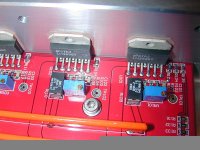Even if you use 0,5 ohm resistors an imbalance of only one volt for whatever reason
Could you please give an example of "whatever reason" as i cannot think of anything capable of introducing a volt of imbalance.
And also an example of JR's use of multiple servos as i only see examples with multiple pots.
Thank you.
Attachments
Last edited:
The unbalance occurs with gain . Each has two 1% resistors . If you consider only one pair paralleled than 4% error in gain can occur. If the output is 30v than an unbalance of 1.2v is presented to 2 x0.1 ohms , draining 6A . This why it is the gains that should be adjusted .
The board in your photo is a Jeff Rowland , the trimmers are for gain , the servos are on the underside
the board in this link is a cheap chinese copy of a Rowland and the last picture shows top and bottom on which you can clearly identify the dc-server ops...........
Buy a kit and analyze it you can buy it with or without the lm3886 chips . it will be worth your trouble I think.....
ZEROZONE (DIY kit) Hifi LM3886 Mono amplifier kit 360W base on JEFF Rowland amp L6 8-in Amplifier from Consumer Electronics on Aliexpress.com | Alibaba Group
Buy a kit and analyze it you can buy it with or without the lm3886 chips . it will be worth your trouble I think.....
ZEROZONE (DIY kit) Hifi LM3886 Mono amplifier kit 360W base on JEFF Rowland amp L6 8-in Amplifier from Consumer Electronics on Aliexpress.com | Alibaba Group
Did you measure any noise on the amp inputs, where the trimmers are connected? I am guessing you connected the trimmers between the power rails.
No, the trimmer is connected between the non-inverting input and the ground. Trimmer aligns the input currents. The ICs are used in inverting mode.
Sorry to disagree . Even if you use 0,5 ohm resistors an imbalance of only one volt for whatever reason will impose a current of 0,5 amps supplied or sunk by the two amps whose outputs are balanced and 1 amp sunk or supplied by the third one which is not and fighting against the other two. Unless you measure differences in temperature with a sensors on top of each chip and simultaneously even then you will not get the actual temp of the die but an averaged outside temperature. One amp in third chip at a rail voltage of 24 volts : do the math yourself..... and at 36 Volts worse still so all I can do is say dont do it even if the customer doesnt want to spend whats truly necesary as when it fails and it will fail YOU will be the one who is blamed....... just explain the maths to the customer.
you do not need expensive op-amps as servos and this plus a few resistors and a small capacitor or two do not cost much compared to the cost of what you are building.
Jeff Rowlands uses them and even the cheap chinese copy mentioned does use TL027s
Do you think I didn't test it properly? 😉 I abused the lab prototype in many ways. It's interesting the input currents are slightly different between the chips, although the trimming matches them well, minimizing the offset.
- Status
- Not open for further replies.
- Home
- Amplifiers
- Solid State
- why bass is tight and controlled on SS than chipamps like lm3886?
